Business Environment Report: British Airways and UK Organizations
VerifiedAdded on 2022/03/29
|17
|5758
|24
Report
AI Summary
This report, prepared for ICON College's HND in Business program, examines the UK business environment, with a specific focus on British Airways. The report begins by categorizing and differentiating various organizational types in the UK, including private, public, and voluntary sectors, providing examples such as British Airways, the National Health Service, and the British Heart Foundation. It then delves into British Airways, analyzing its functions, structure, and interrelationships. The core of the report uses PESTEL analysis to assess the macro-environmental factors impacting British Airways and SWOT analysis to evaluate its internal strengths, weaknesses, and external opportunities and threats. Recommendations are provided based on the analyses, and the report concludes with a critical evaluation of the factors influencing the company's objectives and decision-making processes. The report leverages research and analysis to provide a comprehensive understanding of British Airways within the broader UK business landscape.
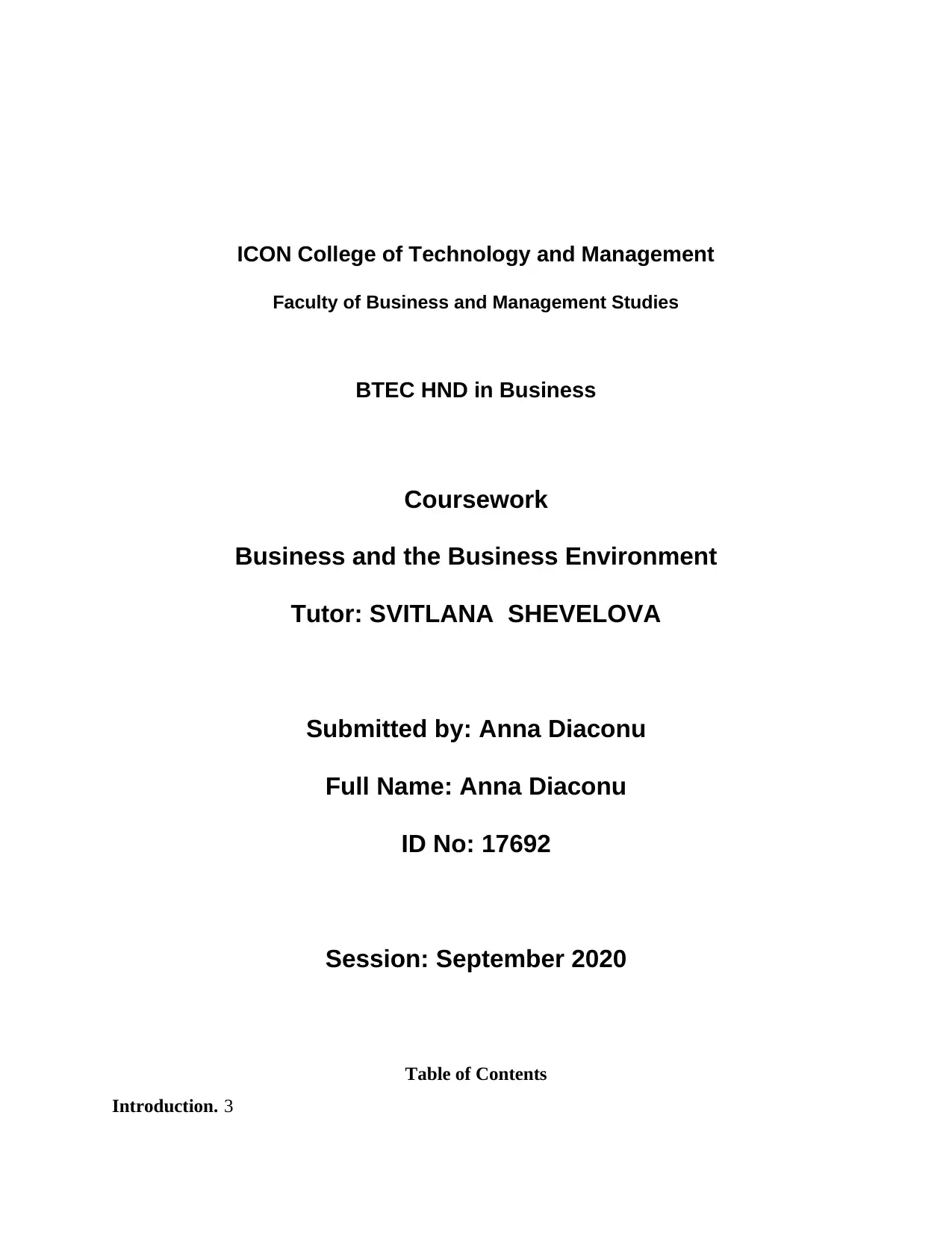
ICON College of Technology and Management
Faculty of Business and Management Studies
BTEC HND in Business
Coursework
Business and the Business Environment
Tutor: SVITLANA SHEVELOVA
Submitted by: Anna Diaconu
Full Name: Anna Diaconu
ID No: 17692
Session: September 2020
Table of Contents
Introduction. 3
Faculty of Business and Management Studies
BTEC HND in Business
Coursework
Business and the Business Environment
Tutor: SVITLANA SHEVELOVA
Submitted by: Anna Diaconu
Full Name: Anna Diaconu
ID No: 17692
Session: September 2020
Table of Contents
Introduction. 3
Paraphrase This Document
Need a fresh take? Get an instant paraphrase of this document with our AI Paraphraser
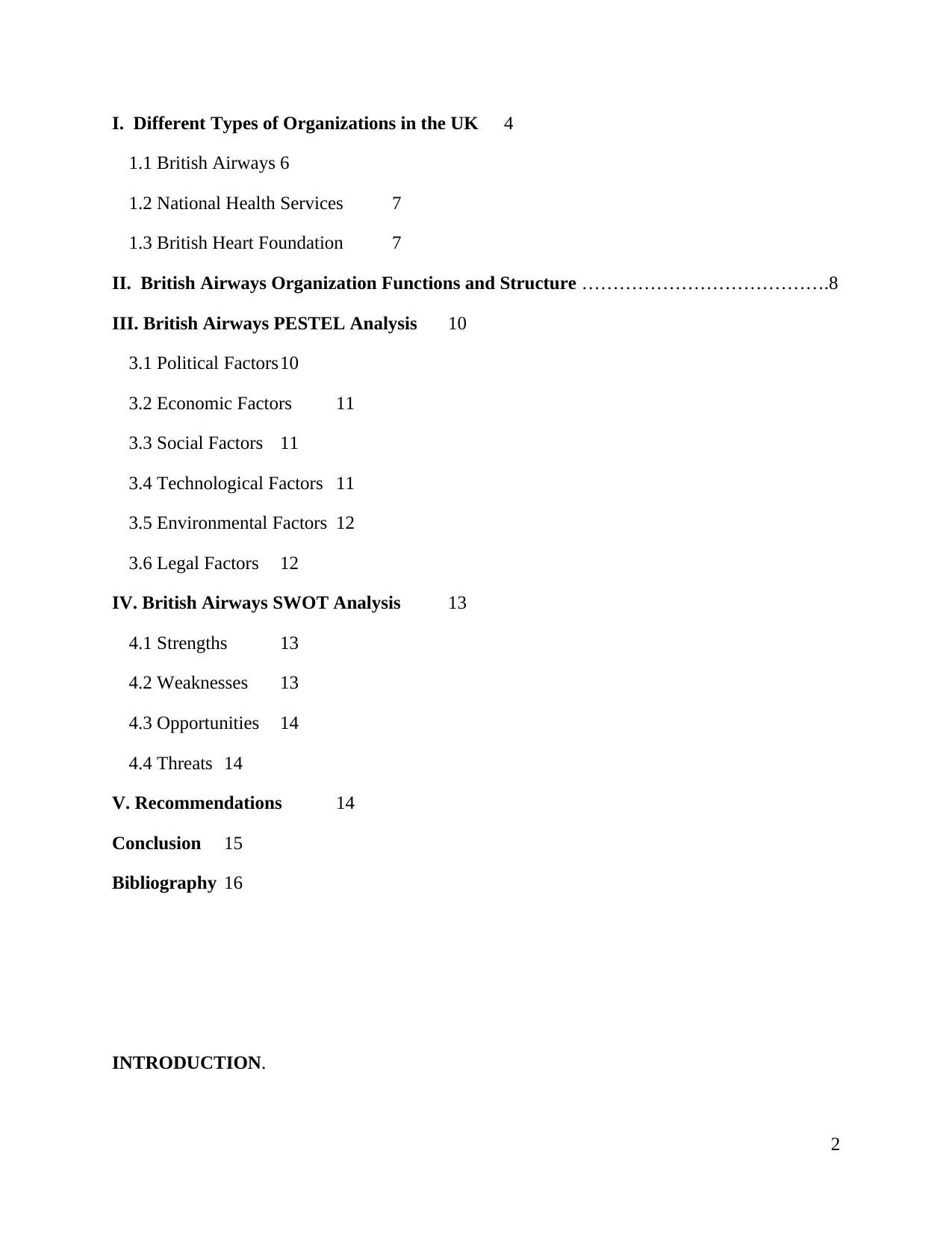
I. Different Types of Organizations in the UK 4
1.1 British Airways 6
1.2 National Health Services 7
1.3 British Heart Foundation 7
II. British Airways Organization Functions and Structure ………………………………….8
III. British Airways PESTEL Analysis 10
3.1 Political Factors10
3.2 Economic Factors 11
3.3 Social Factors 11
3.4 Technological Factors 11
3.5 Environmental Factors 12
3.6 Legal Factors 12
IV. British Airways SWOT Analysis 13
4.1 Strengths 13
4.2 Weaknesses 13
4.3 Opportunities 14
4.4 Threats 14
V. Recommendations 14
Conclusion 15
Bibliography 16
INTRODUCTION.
2
1.1 British Airways 6
1.2 National Health Services 7
1.3 British Heart Foundation 7
II. British Airways Organization Functions and Structure ………………………………….8
III. British Airways PESTEL Analysis 10
3.1 Political Factors10
3.2 Economic Factors 11
3.3 Social Factors 11
3.4 Technological Factors 11
3.5 Environmental Factors 12
3.6 Legal Factors 12
IV. British Airways SWOT Analysis 13
4.1 Strengths 13
4.2 Weaknesses 13
4.3 Opportunities 14
4.4 Threats 14
V. Recommendations 14
Conclusion 15
Bibliography 16
INTRODUCTION.
2
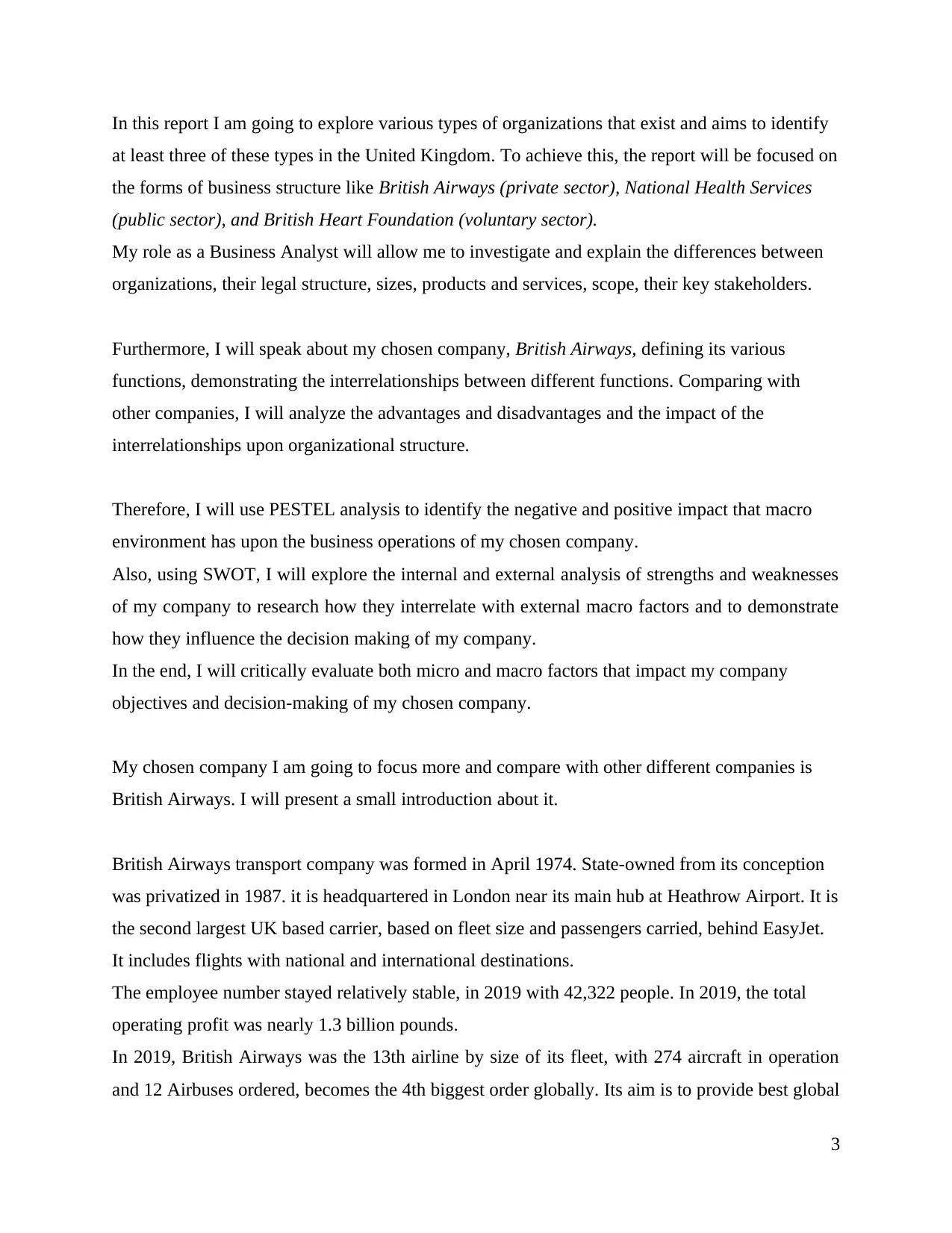
In this report I am going to explore various types of organizations that exist and aims to identify
at least three of these types in the United Kingdom. To achieve this, the report will be focused on
the forms of business structure like British Airways (private sector), National Health Services
(public sector), and British Heart Foundation (voluntary sector).
My role as a Business Analyst will allow me to investigate and explain the differences between
organizations, their legal structure, sizes, products and services, scope, their key stakeholders.
Furthermore, I will speak about my chosen company, British Airways, defining its various
functions, demonstrating the interrelationships between different functions. Comparing with
other companies, I will analyze the advantages and disadvantages and the impact of the
interrelationships upon organizational structure.
Therefore, I will use PESTEL analysis to identify the negative and positive impact that macro
environment has upon the business operations of my chosen company.
Also, using SWOT, I will explore the internal and external analysis of strengths and weaknesses
of my company to research how they interrelate with external macro factors and to demonstrate
how they influence the decision making of my company.
In the end, I will critically evaluate both micro and macro factors that impact my company
objectives and decision-making of my chosen company.
My chosen company I am going to focus more and compare with other different companies is
British Airways. I will present a small introduction about it.
British Airways transport company was formed in April 1974. State-owned from its conception
was privatized in 1987. it is headquartered in London near its main hub at Heathrow Airport. It is
the second largest UK based carrier, based on fleet size and passengers carried, behind EasyJet.
It includes flights with national and international destinations.
The employee number stayed relatively stable, in 2019 with 42,322 people. In 2019, the total
operating profit was nearly 1.3 billion pounds.
In 2019, British Airways was the 13th airline by size of its fleet, with 274 aircraft in operation
and 12 Airbuses ordered, becomes the 4th biggest order globally. Its aim is to provide best global
3
at least three of these types in the United Kingdom. To achieve this, the report will be focused on
the forms of business structure like British Airways (private sector), National Health Services
(public sector), and British Heart Foundation (voluntary sector).
My role as a Business Analyst will allow me to investigate and explain the differences between
organizations, their legal structure, sizes, products and services, scope, their key stakeholders.
Furthermore, I will speak about my chosen company, British Airways, defining its various
functions, demonstrating the interrelationships between different functions. Comparing with
other companies, I will analyze the advantages and disadvantages and the impact of the
interrelationships upon organizational structure.
Therefore, I will use PESTEL analysis to identify the negative and positive impact that macro
environment has upon the business operations of my chosen company.
Also, using SWOT, I will explore the internal and external analysis of strengths and weaknesses
of my company to research how they interrelate with external macro factors and to demonstrate
how they influence the decision making of my company.
In the end, I will critically evaluate both micro and macro factors that impact my company
objectives and decision-making of my chosen company.
My chosen company I am going to focus more and compare with other different companies is
British Airways. I will present a small introduction about it.
British Airways transport company was formed in April 1974. State-owned from its conception
was privatized in 1987. it is headquartered in London near its main hub at Heathrow Airport. It is
the second largest UK based carrier, based on fleet size and passengers carried, behind EasyJet.
It includes flights with national and international destinations.
The employee number stayed relatively stable, in 2019 with 42,322 people. In 2019, the total
operating profit was nearly 1.3 billion pounds.
In 2019, British Airways was the 13th airline by size of its fleet, with 274 aircraft in operation
and 12 Airbuses ordered, becomes the 4th biggest order globally. Its aim is to provide best global
3
⊘ This is a preview!⊘
Do you want full access?
Subscribe today to unlock all pages.

Trusted by 1+ million students worldwide
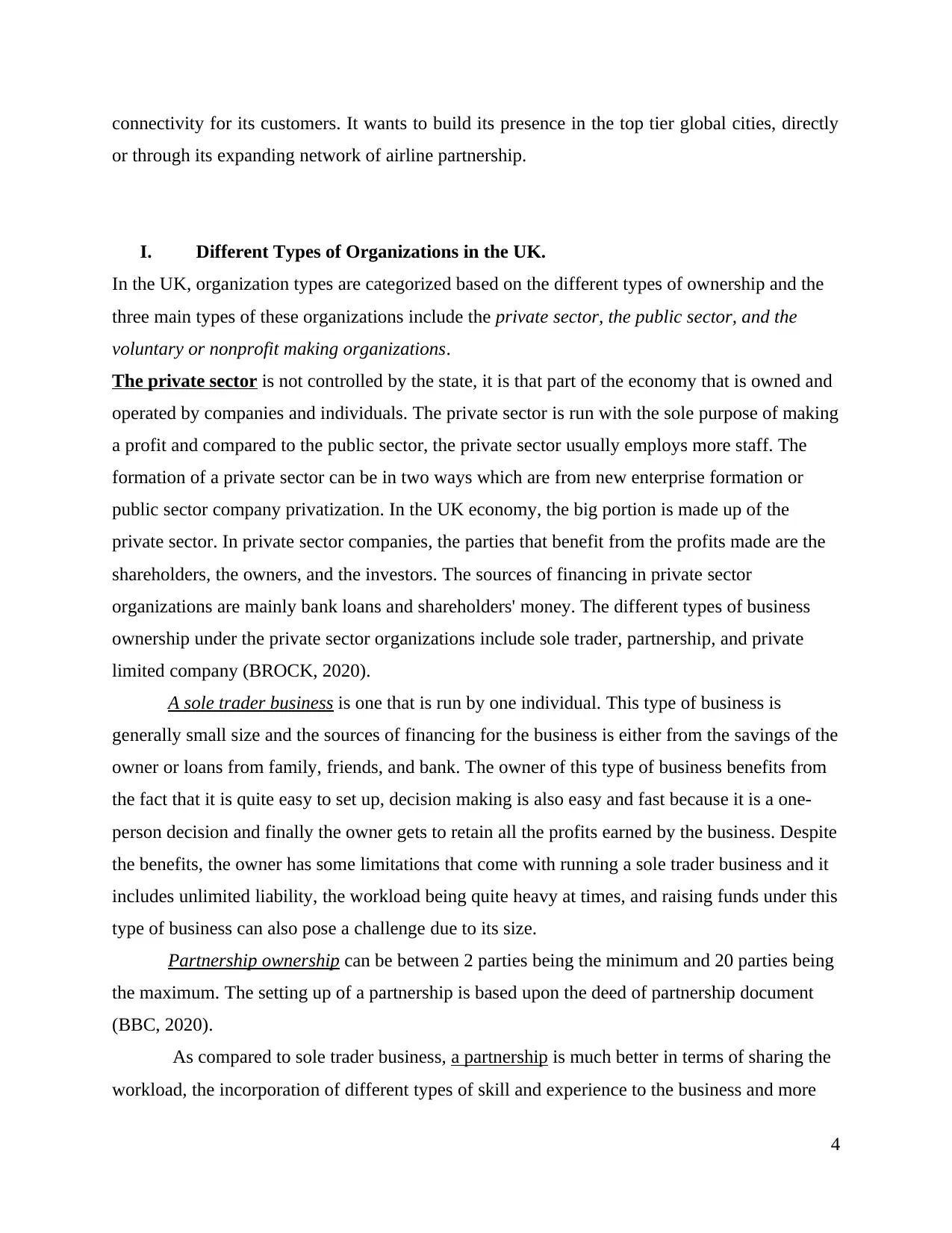
connectivity for its customers. It wants to build its presence in the top tier global cities, directly
or through its expanding network of airline partnership.
I. Different Types of Organizations in the UK.
In the UK, organization types are categorized based on the different types of ownership and the
three main types of these organizations include the private sector, the public sector, and the
voluntary or nonprofit making organizations.
The private sector is not controlled by the state, it is that part of the economy that is owned and
operated by companies and individuals. The private sector is run with the sole purpose of making
a profit and compared to the public sector, the private sector usually employs more staff. The
formation of a private sector can be in two ways which are from new enterprise formation or
public sector company privatization. In the UK economy, the big portion is made up of the
private sector. In private sector companies, the parties that benefit from the profits made are the
shareholders, the owners, and the investors. The sources of financing in private sector
organizations are mainly bank loans and shareholders' money. The different types of business
ownership under the private sector organizations include sole trader, partnership, and private
limited company (BROCK, 2020).
A sole trader business is one that is run by one individual. This type of business is
generally small size and the sources of financing for the business is either from the savings of the
owner or loans from family, friends, and bank. The owner of this type of business benefits from
the fact that it is quite easy to set up, decision making is also easy and fast because it is a one-
person decision and finally the owner gets to retain all the profits earned by the business. Despite
the benefits, the owner has some limitations that come with running a sole trader business and it
includes unlimited liability, the workload being quite heavy at times, and raising funds under this
type of business can also pose a challenge due to its size.
Partnership ownership can be between 2 parties being the minimum and 20 parties being
the maximum. The setting up of a partnership is based upon the deed of partnership document
(BBC, 2020).
As compared to sole trader business, a partnership is much better in terms of sharing the
workload, the incorporation of different types of skill and experience to the business and more
4
or through its expanding network of airline partnership.
I. Different Types of Organizations in the UK.
In the UK, organization types are categorized based on the different types of ownership and the
three main types of these organizations include the private sector, the public sector, and the
voluntary or nonprofit making organizations.
The private sector is not controlled by the state, it is that part of the economy that is owned and
operated by companies and individuals. The private sector is run with the sole purpose of making
a profit and compared to the public sector, the private sector usually employs more staff. The
formation of a private sector can be in two ways which are from new enterprise formation or
public sector company privatization. In the UK economy, the big portion is made up of the
private sector. In private sector companies, the parties that benefit from the profits made are the
shareholders, the owners, and the investors. The sources of financing in private sector
organizations are mainly bank loans and shareholders' money. The different types of business
ownership under the private sector organizations include sole trader, partnership, and private
limited company (BROCK, 2020).
A sole trader business is one that is run by one individual. This type of business is
generally small size and the sources of financing for the business is either from the savings of the
owner or loans from family, friends, and bank. The owner of this type of business benefits from
the fact that it is quite easy to set up, decision making is also easy and fast because it is a one-
person decision and finally the owner gets to retain all the profits earned by the business. Despite
the benefits, the owner has some limitations that come with running a sole trader business and it
includes unlimited liability, the workload being quite heavy at times, and raising funds under this
type of business can also pose a challenge due to its size.
Partnership ownership can be between 2 parties being the minimum and 20 parties being
the maximum. The setting up of a partnership is based upon the deed of partnership document
(BBC, 2020).
As compared to sole trader business, a partnership is much better in terms of sharing the
workload, the incorporation of different types of skill and experience to the business and more
4
Paraphrase This Document
Need a fresh take? Get an instant paraphrase of this document with our AI Paraphraser
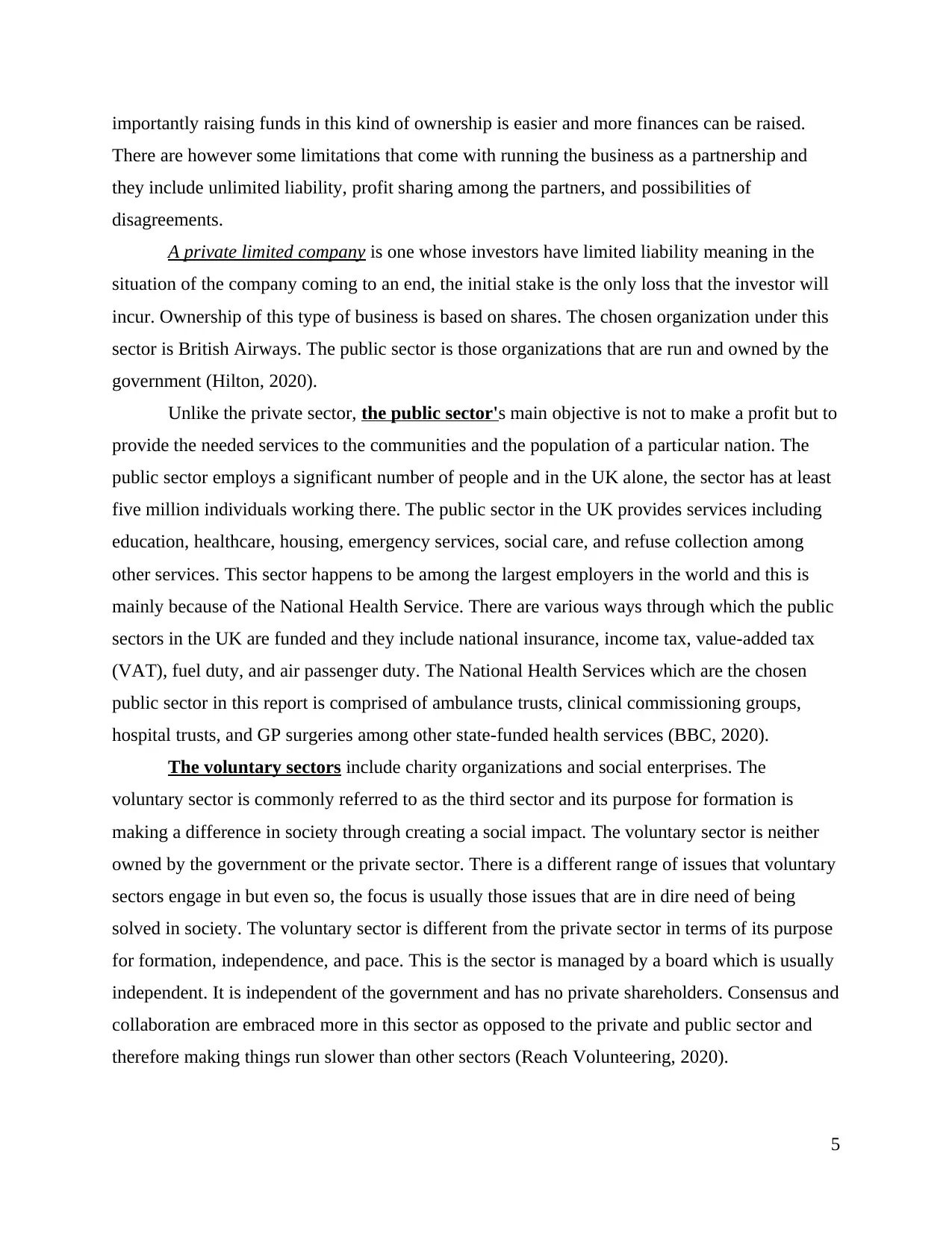
importantly raising funds in this kind of ownership is easier and more finances can be raised.
There are however some limitations that come with running the business as a partnership and
they include unlimited liability, profit sharing among the partners, and possibilities of
disagreements.
A private limited company is one whose investors have limited liability meaning in the
situation of the company coming to an end, the initial stake is the only loss that the investor will
incur. Ownership of this type of business is based on shares. The chosen organization under this
sector is British Airways. The public sector is those organizations that are run and owned by the
government (Hilton, 2020).
Unlike the private sector, the public sector's main objective is not to make a profit but to
provide the needed services to the communities and the population of a particular nation. The
public sector employs a significant number of people and in the UK alone, the sector has at least
five million individuals working there. The public sector in the UK provides services including
education, healthcare, housing, emergency services, social care, and refuse collection among
other services. This sector happens to be among the largest employers in the world and this is
mainly because of the National Health Service. There are various ways through which the public
sectors in the UK are funded and they include national insurance, income tax, value-added tax
(VAT), fuel duty, and air passenger duty. The National Health Services which are the chosen
public sector in this report is comprised of ambulance trusts, clinical commissioning groups,
hospital trusts, and GP surgeries among other state-funded health services (BBC, 2020).
The voluntary sectors include charity organizations and social enterprises. The
voluntary sector is commonly referred to as the third sector and its purpose for formation is
making a difference in society through creating a social impact. The voluntary sector is neither
owned by the government or the private sector. There is a different range of issues that voluntary
sectors engage in but even so, the focus is usually those issues that are in dire need of being
solved in society. The voluntary sector is different from the private sector in terms of its purpose
for formation, independence, and pace. This is the sector is managed by a board which is usually
independent. It is independent of the government and has no private shareholders. Consensus and
collaboration are embraced more in this sector as opposed to the private and public sector and
therefore making things run slower than other sectors (Reach Volunteering, 2020).
5
There are however some limitations that come with running the business as a partnership and
they include unlimited liability, profit sharing among the partners, and possibilities of
disagreements.
A private limited company is one whose investors have limited liability meaning in the
situation of the company coming to an end, the initial stake is the only loss that the investor will
incur. Ownership of this type of business is based on shares. The chosen organization under this
sector is British Airways. The public sector is those organizations that are run and owned by the
government (Hilton, 2020).
Unlike the private sector, the public sector's main objective is not to make a profit but to
provide the needed services to the communities and the population of a particular nation. The
public sector employs a significant number of people and in the UK alone, the sector has at least
five million individuals working there. The public sector in the UK provides services including
education, healthcare, housing, emergency services, social care, and refuse collection among
other services. This sector happens to be among the largest employers in the world and this is
mainly because of the National Health Service. There are various ways through which the public
sectors in the UK are funded and they include national insurance, income tax, value-added tax
(VAT), fuel duty, and air passenger duty. The National Health Services which are the chosen
public sector in this report is comprised of ambulance trusts, clinical commissioning groups,
hospital trusts, and GP surgeries among other state-funded health services (BBC, 2020).
The voluntary sectors include charity organizations and social enterprises. The
voluntary sector is commonly referred to as the third sector and its purpose for formation is
making a difference in society through creating a social impact. The voluntary sector is neither
owned by the government or the private sector. There is a different range of issues that voluntary
sectors engage in but even so, the focus is usually those issues that are in dire need of being
solved in society. The voluntary sector is different from the private sector in terms of its purpose
for formation, independence, and pace. This is the sector is managed by a board which is usually
independent. It is independent of the government and has no private shareholders. Consensus and
collaboration are embraced more in this sector as opposed to the private and public sector and
therefore making things run slower than other sectors (Reach Volunteering, 2020).
5
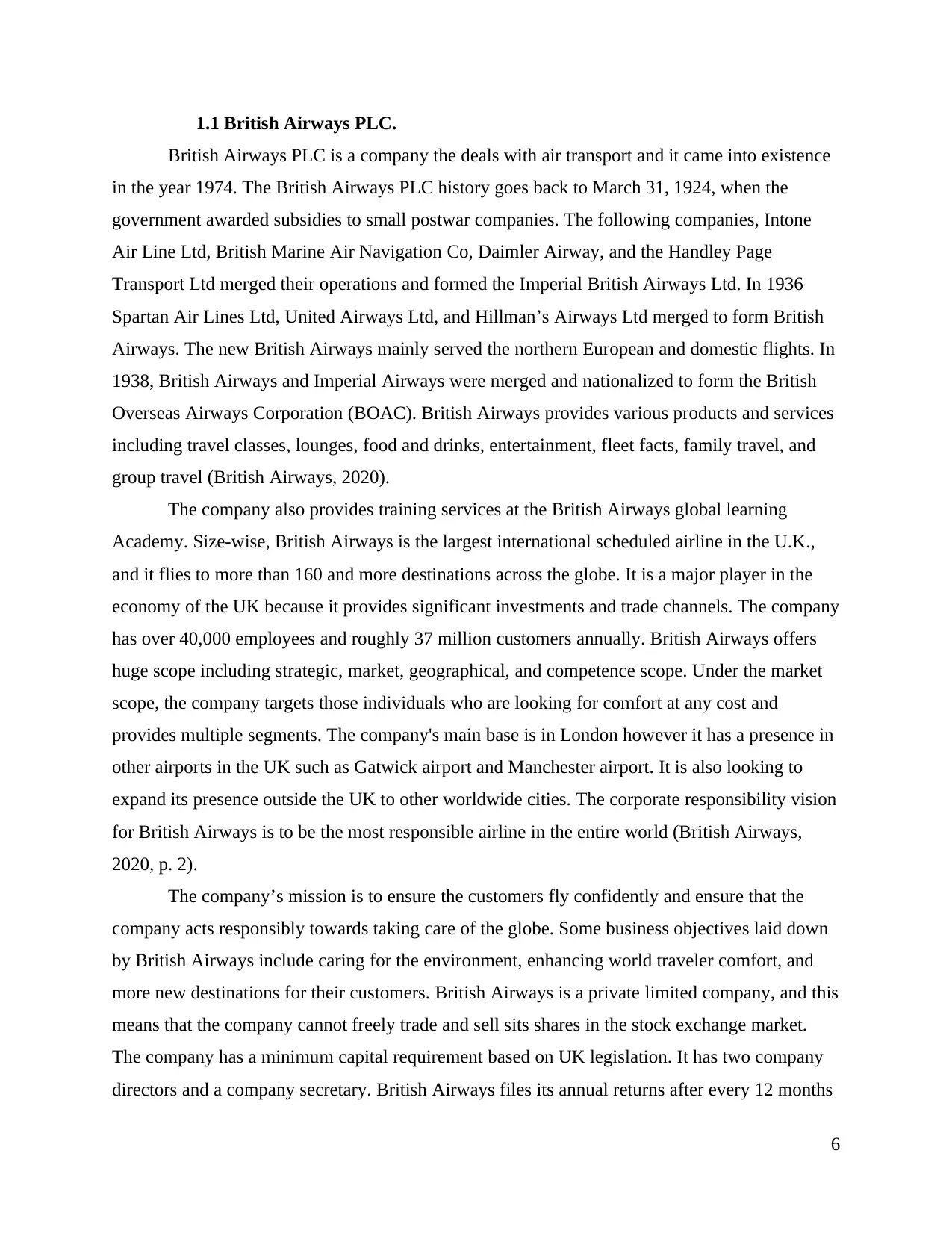
1.1 British Airways PLC.
British Airways PLC is a company the deals with air transport and it came into existence
in the year 1974. The British Airways PLC history goes back to March 31, 1924, when the
government awarded subsidies to small postwar companies. The following companies, Intone
Air Line Ltd, British Marine Air Navigation Co, Daimler Airway, and the Handley Page
Transport Ltd merged their operations and formed the Imperial British Airways Ltd. In 1936
Spartan Air Lines Ltd, United Airways Ltd, and Hillman’s Airways Ltd merged to form British
Airways. The new British Airways mainly served the northern European and domestic flights. In
1938, British Airways and Imperial Airways were merged and nationalized to form the British
Overseas Airways Corporation (BOAC). British Airways provides various products and services
including travel classes, lounges, food and drinks, entertainment, fleet facts, family travel, and
group travel (British Airways, 2020).
The company also provides training services at the British Airways global learning
Academy. Size-wise, British Airways is the largest international scheduled airline in the U.K.,
and it flies to more than 160 and more destinations across the globe. It is a major player in the
economy of the UK because it provides significant investments and trade channels. The company
has over 40,000 employees and roughly 37 million customers annually. British Airways offers
huge scope including strategic, market, geographical, and competence scope. Under the market
scope, the company targets those individuals who are looking for comfort at any cost and
provides multiple segments. The company's main base is in London however it has a presence in
other airports in the UK such as Gatwick airport and Manchester airport. It is also looking to
expand its presence outside the UK to other worldwide cities. The corporate responsibility vision
for British Airways is to be the most responsible airline in the entire world (British Airways,
2020, p. 2).
The company’s mission is to ensure the customers fly confidently and ensure that the
company acts responsibly towards taking care of the globe. Some business objectives laid down
by British Airways include caring for the environment, enhancing world traveler comfort, and
more new destinations for their customers. British Airways is a private limited company, and this
means that the company cannot freely trade and sell sits shares in the stock exchange market.
The company has a minimum capital requirement based on UK legislation. It has two company
directors and a company secretary. British Airways files its annual returns after every 12 months
6
British Airways PLC is a company the deals with air transport and it came into existence
in the year 1974. The British Airways PLC history goes back to March 31, 1924, when the
government awarded subsidies to small postwar companies. The following companies, Intone
Air Line Ltd, British Marine Air Navigation Co, Daimler Airway, and the Handley Page
Transport Ltd merged their operations and formed the Imperial British Airways Ltd. In 1936
Spartan Air Lines Ltd, United Airways Ltd, and Hillman’s Airways Ltd merged to form British
Airways. The new British Airways mainly served the northern European and domestic flights. In
1938, British Airways and Imperial Airways were merged and nationalized to form the British
Overseas Airways Corporation (BOAC). British Airways provides various products and services
including travel classes, lounges, food and drinks, entertainment, fleet facts, family travel, and
group travel (British Airways, 2020).
The company also provides training services at the British Airways global learning
Academy. Size-wise, British Airways is the largest international scheduled airline in the U.K.,
and it flies to more than 160 and more destinations across the globe. It is a major player in the
economy of the UK because it provides significant investments and trade channels. The company
has over 40,000 employees and roughly 37 million customers annually. British Airways offers
huge scope including strategic, market, geographical, and competence scope. Under the market
scope, the company targets those individuals who are looking for comfort at any cost and
provides multiple segments. The company's main base is in London however it has a presence in
other airports in the UK such as Gatwick airport and Manchester airport. It is also looking to
expand its presence outside the UK to other worldwide cities. The corporate responsibility vision
for British Airways is to be the most responsible airline in the entire world (British Airways,
2020, p. 2).
The company’s mission is to ensure the customers fly confidently and ensure that the
company acts responsibly towards taking care of the globe. Some business objectives laid down
by British Airways include caring for the environment, enhancing world traveler comfort, and
more new destinations for their customers. British Airways is a private limited company, and this
means that the company cannot freely trade and sell sits shares in the stock exchange market.
The company has a minimum capital requirement based on UK legislation. It has two company
directors and a company secretary. British Airways files its annual returns after every 12 months
6
⊘ This is a preview!⊘
Do you want full access?
Subscribe today to unlock all pages.

Trusted by 1+ million students worldwide
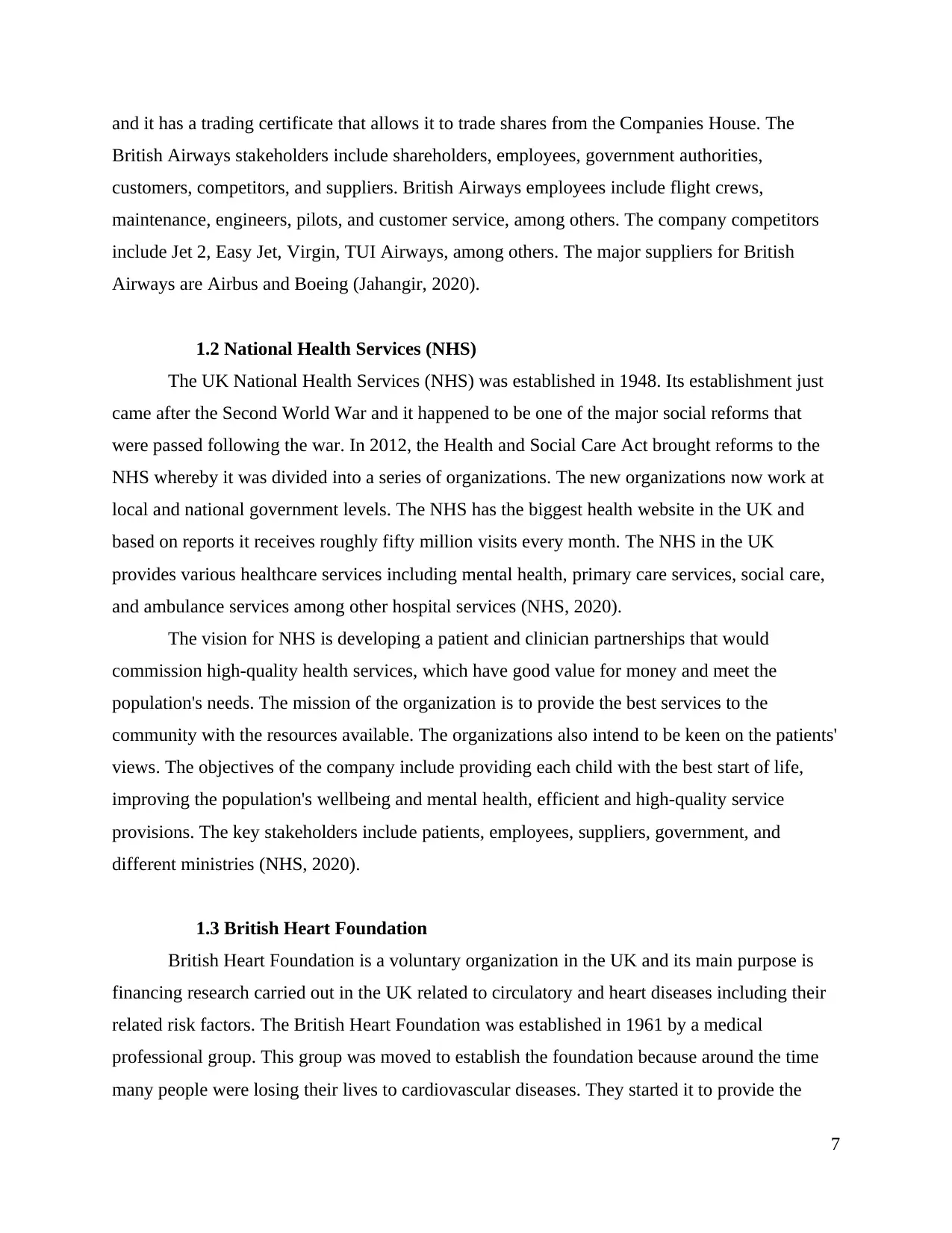
and it has a trading certificate that allows it to trade shares from the Companies House. The
British Airways stakeholders include shareholders, employees, government authorities,
customers, competitors, and suppliers. British Airways employees include flight crews,
maintenance, engineers, pilots, and customer service, among others. The company competitors
include Jet 2, Easy Jet, Virgin, TUI Airways, among others. The major suppliers for British
Airways are Airbus and Boeing (Jahangir, 2020).
1.2 National Health Services (NHS)
The UK National Health Services (NHS) was established in 1948. Its establishment just
came after the Second World War and it happened to be one of the major social reforms that
were passed following the war. In 2012, the Health and Social Care Act brought reforms to the
NHS whereby it was divided into a series of organizations. The new organizations now work at
local and national government levels. The NHS has the biggest health website in the UK and
based on reports it receives roughly fifty million visits every month. The NHS in the UK
provides various healthcare services including mental health, primary care services, social care,
and ambulance services among other hospital services (NHS, 2020).
The vision for NHS is developing a patient and clinician partnerships that would
commission high-quality health services, which have good value for money and meet the
population's needs. The mission of the organization is to provide the best services to the
community with the resources available. The organizations also intend to be keen on the patients'
views. The objectives of the company include providing each child with the best start of life,
improving the population's wellbeing and mental health, efficient and high-quality service
provisions. The key stakeholders include patients, employees, suppliers, government, and
different ministries (NHS, 2020).
1.3 British Heart Foundation
British Heart Foundation is a voluntary organization in the UK and its main purpose is
financing research carried out in the UK related to circulatory and heart diseases including their
related risk factors. The British Heart Foundation was established in 1961 by a medical
professional group. This group was moved to establish the foundation because around the time
many people were losing their lives to cardiovascular diseases. They started it to provide the
7
British Airways stakeholders include shareholders, employees, government authorities,
customers, competitors, and suppliers. British Airways employees include flight crews,
maintenance, engineers, pilots, and customer service, among others. The company competitors
include Jet 2, Easy Jet, Virgin, TUI Airways, among others. The major suppliers for British
Airways are Airbus and Boeing (Jahangir, 2020).
1.2 National Health Services (NHS)
The UK National Health Services (NHS) was established in 1948. Its establishment just
came after the Second World War and it happened to be one of the major social reforms that
were passed following the war. In 2012, the Health and Social Care Act brought reforms to the
NHS whereby it was divided into a series of organizations. The new organizations now work at
local and national government levels. The NHS has the biggest health website in the UK and
based on reports it receives roughly fifty million visits every month. The NHS in the UK
provides various healthcare services including mental health, primary care services, social care,
and ambulance services among other hospital services (NHS, 2020).
The vision for NHS is developing a patient and clinician partnerships that would
commission high-quality health services, which have good value for money and meet the
population's needs. The mission of the organization is to provide the best services to the
community with the resources available. The organizations also intend to be keen on the patients'
views. The objectives of the company include providing each child with the best start of life,
improving the population's wellbeing and mental health, efficient and high-quality service
provisions. The key stakeholders include patients, employees, suppliers, government, and
different ministries (NHS, 2020).
1.3 British Heart Foundation
British Heart Foundation is a voluntary organization in the UK and its main purpose is
financing research carried out in the UK related to circulatory and heart diseases including their
related risk factors. The British Heart Foundation was established in 1961 by a medical
professional group. This group was moved to establish the foundation because around the time
many people were losing their lives to cardiovascular diseases. They started it to provide the
7
Paraphrase This Document
Need a fresh take? Get an instant paraphrase of this document with our AI Paraphraser
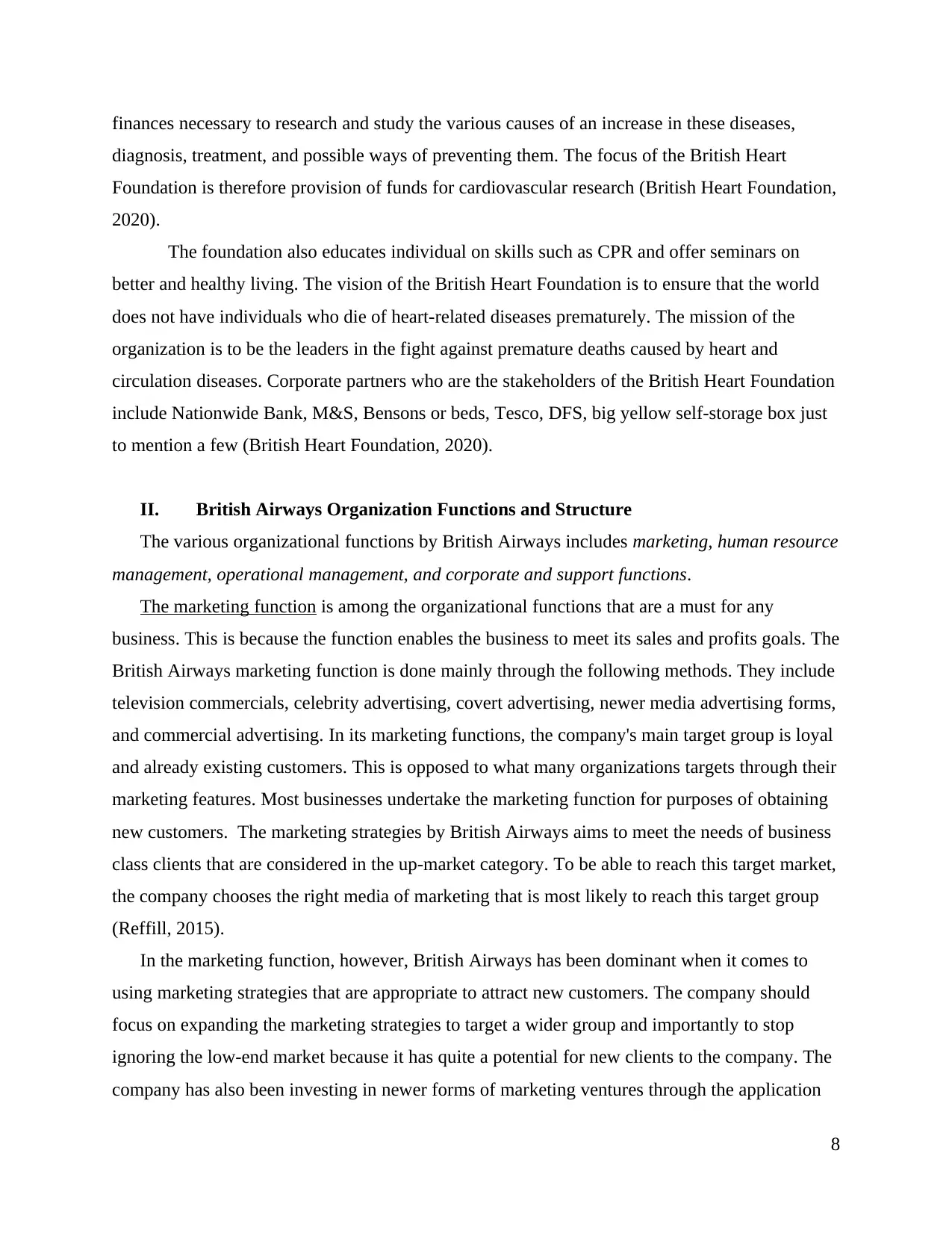
finances necessary to research and study the various causes of an increase in these diseases,
diagnosis, treatment, and possible ways of preventing them. The focus of the British Heart
Foundation is therefore provision of funds for cardiovascular research (British Heart Foundation,
2020).
The foundation also educates individual on skills such as CPR and offer seminars on
better and healthy living. The vision of the British Heart Foundation is to ensure that the world
does not have individuals who die of heart-related diseases prematurely. The mission of the
organization is to be the leaders in the fight against premature deaths caused by heart and
circulation diseases. Corporate partners who are the stakeholders of the British Heart Foundation
include Nationwide Bank, M&S, Bensons or beds, Tesco, DFS, big yellow self-storage box just
to mention a few (British Heart Foundation, 2020).
II. British Airways Organization Functions and Structure
The various organizational functions by British Airways includes marketing, human resource
management, operational management, and corporate and support functions.
The marketing function is among the organizational functions that are a must for any
business. This is because the function enables the business to meet its sales and profits goals. The
British Airways marketing function is done mainly through the following methods. They include
television commercials, celebrity advertising, covert advertising, newer media advertising forms,
and commercial advertising. In its marketing functions, the company's main target group is loyal
and already existing customers. This is opposed to what many organizations targets through their
marketing features. Most businesses undertake the marketing function for purposes of obtaining
new customers. The marketing strategies by British Airways aims to meet the needs of business
class clients that are considered in the up-market category. To be able to reach this target market,
the company chooses the right media of marketing that is most likely to reach this target group
(Reffill, 2015).
In the marketing function, however, British Airways has been dominant when it comes to
using marketing strategies that are appropriate to attract new customers. The company should
focus on expanding the marketing strategies to target a wider group and importantly to stop
ignoring the low-end market because it has quite a potential for new clients to the company. The
company has also been investing in newer forms of marketing ventures through the application
8
diagnosis, treatment, and possible ways of preventing them. The focus of the British Heart
Foundation is therefore provision of funds for cardiovascular research (British Heart Foundation,
2020).
The foundation also educates individual on skills such as CPR and offer seminars on
better and healthy living. The vision of the British Heart Foundation is to ensure that the world
does not have individuals who die of heart-related diseases prematurely. The mission of the
organization is to be the leaders in the fight against premature deaths caused by heart and
circulation diseases. Corporate partners who are the stakeholders of the British Heart Foundation
include Nationwide Bank, M&S, Bensons or beds, Tesco, DFS, big yellow self-storage box just
to mention a few (British Heart Foundation, 2020).
II. British Airways Organization Functions and Structure
The various organizational functions by British Airways includes marketing, human resource
management, operational management, and corporate and support functions.
The marketing function is among the organizational functions that are a must for any
business. This is because the function enables the business to meet its sales and profits goals. The
British Airways marketing function is done mainly through the following methods. They include
television commercials, celebrity advertising, covert advertising, newer media advertising forms,
and commercial advertising. In its marketing functions, the company's main target group is loyal
and already existing customers. This is opposed to what many organizations targets through their
marketing features. Most businesses undertake the marketing function for purposes of obtaining
new customers. The marketing strategies by British Airways aims to meet the needs of business
class clients that are considered in the up-market category. To be able to reach this target market,
the company chooses the right media of marketing that is most likely to reach this target group
(Reffill, 2015).
In the marketing function, however, British Airways has been dominant when it comes to
using marketing strategies that are appropriate to attract new customers. The company should
focus on expanding the marketing strategies to target a wider group and importantly to stop
ignoring the low-end market because it has quite a potential for new clients to the company. The
company has also been investing in newer forms of marketing ventures through the application
8
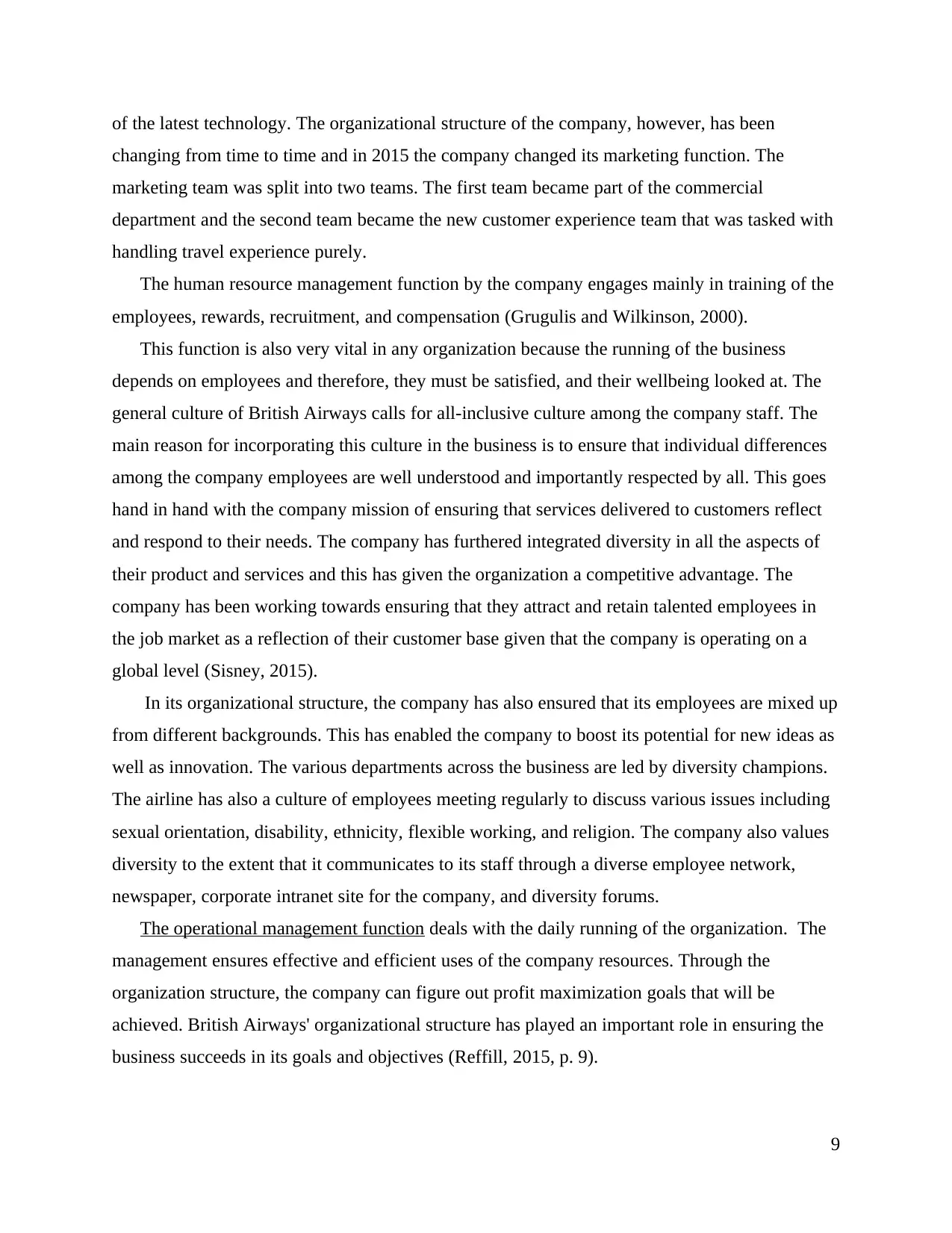
of the latest technology. The organizational structure of the company, however, has been
changing from time to time and in 2015 the company changed its marketing function. The
marketing team was split into two teams. The first team became part of the commercial
department and the second team became the new customer experience team that was tasked with
handling travel experience purely.
The human resource management function by the company engages mainly in training of the
employees, rewards, recruitment, and compensation (Grugulis and Wilkinson, 2000).
This function is also very vital in any organization because the running of the business
depends on employees and therefore, they must be satisfied, and their wellbeing looked at. The
general culture of British Airways calls for all-inclusive culture among the company staff. The
main reason for incorporating this culture in the business is to ensure that individual differences
among the company employees are well understood and importantly respected by all. This goes
hand in hand with the company mission of ensuring that services delivered to customers reflect
and respond to their needs. The company has furthered integrated diversity in all the aspects of
their product and services and this has given the organization a competitive advantage. The
company has been working towards ensuring that they attract and retain talented employees in
the job market as a reflection of their customer base given that the company is operating on a
global level (Sisney, 2015).
In its organizational structure, the company has also ensured that its employees are mixed up
from different backgrounds. This has enabled the company to boost its potential for new ideas as
well as innovation. The various departments across the business are led by diversity champions.
The airline has also a culture of employees meeting regularly to discuss various issues including
sexual orientation, disability, ethnicity, flexible working, and religion. The company also values
diversity to the extent that it communicates to its staff through a diverse employee network,
newspaper, corporate intranet site for the company, and diversity forums.
The operational management function deals with the daily running of the organization. The
management ensures effective and efficient uses of the company resources. Through the
organization structure, the company can figure out profit maximization goals that will be
achieved. British Airways' organizational structure has played an important role in ensuring the
business succeeds in its goals and objectives (Reffill, 2015, p. 9).
9
changing from time to time and in 2015 the company changed its marketing function. The
marketing team was split into two teams. The first team became part of the commercial
department and the second team became the new customer experience team that was tasked with
handling travel experience purely.
The human resource management function by the company engages mainly in training of the
employees, rewards, recruitment, and compensation (Grugulis and Wilkinson, 2000).
This function is also very vital in any organization because the running of the business
depends on employees and therefore, they must be satisfied, and their wellbeing looked at. The
general culture of British Airways calls for all-inclusive culture among the company staff. The
main reason for incorporating this culture in the business is to ensure that individual differences
among the company employees are well understood and importantly respected by all. This goes
hand in hand with the company mission of ensuring that services delivered to customers reflect
and respond to their needs. The company has furthered integrated diversity in all the aspects of
their product and services and this has given the organization a competitive advantage. The
company has been working towards ensuring that they attract and retain talented employees in
the job market as a reflection of their customer base given that the company is operating on a
global level (Sisney, 2015).
In its organizational structure, the company has also ensured that its employees are mixed up
from different backgrounds. This has enabled the company to boost its potential for new ideas as
well as innovation. The various departments across the business are led by diversity champions.
The airline has also a culture of employees meeting regularly to discuss various issues including
sexual orientation, disability, ethnicity, flexible working, and religion. The company also values
diversity to the extent that it communicates to its staff through a diverse employee network,
newspaper, corporate intranet site for the company, and diversity forums.
The operational management function deals with the daily running of the organization. The
management ensures effective and efficient uses of the company resources. Through the
organization structure, the company can figure out profit maximization goals that will be
achieved. British Airways' organizational structure has played an important role in ensuring the
business succeeds in its goals and objectives (Reffill, 2015, p. 9).
9
⊘ This is a preview!⊘
Do you want full access?
Subscribe today to unlock all pages.

Trusted by 1+ million students worldwide
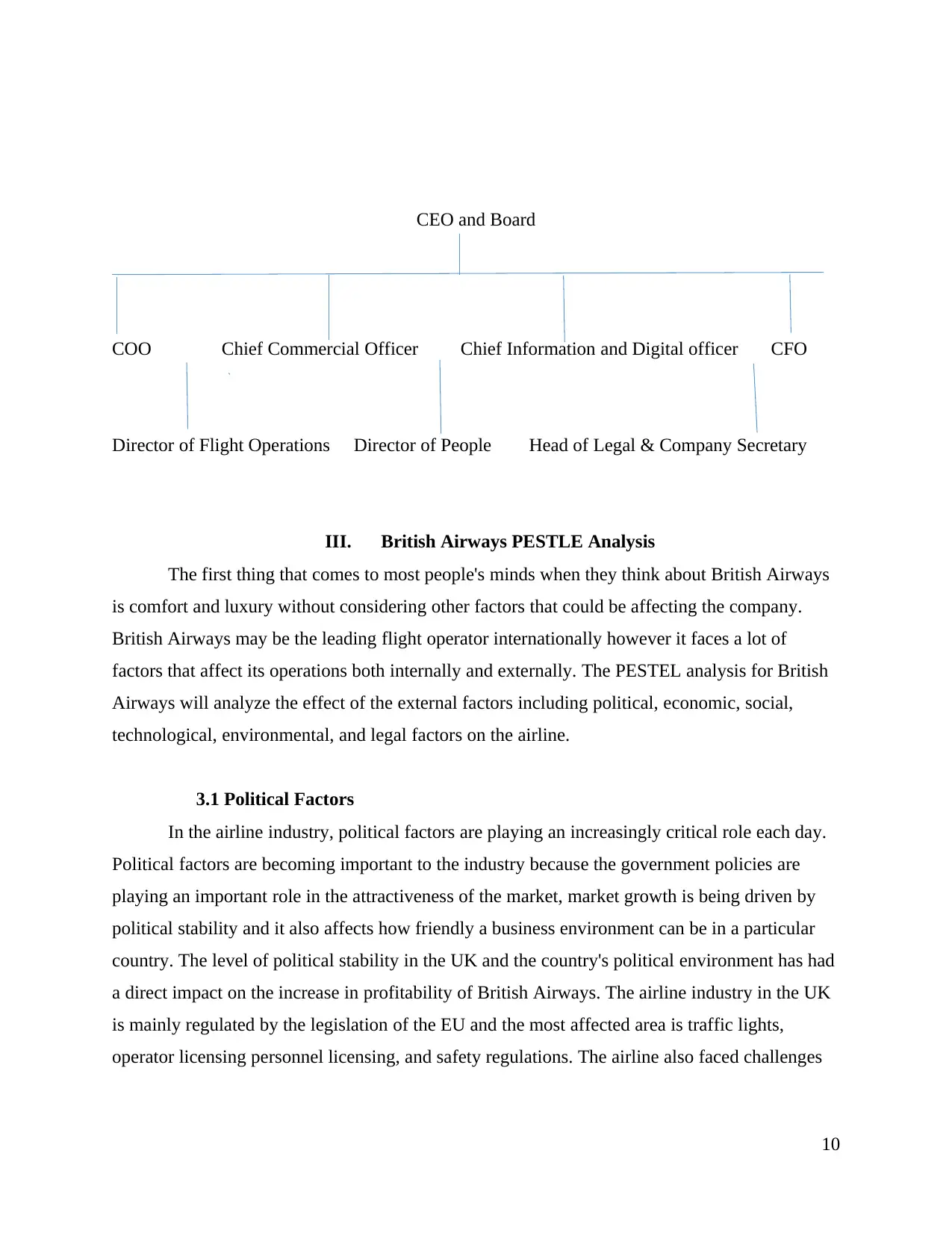
CEO and Board
COO Chief Commercial Officer Chief Information and Digital officer CFO
Director of Flight Operations Director of People Head of Legal & Company Secretary
III. British Airways PESTLE Analysis
The first thing that comes to most people's minds when they think about British Airways
is comfort and luxury without considering other factors that could be affecting the company.
British Airways may be the leading flight operator internationally however it faces a lot of
factors that affect its operations both internally and externally. The PESTEL analysis for British
Airways will analyze the effect of the external factors including political, economic, social,
technological, environmental, and legal factors on the airline.
3.1 Political Factors
In the airline industry, political factors are playing an increasingly critical role each day.
Political factors are becoming important to the industry because the government policies are
playing an important role in the attractiveness of the market, market growth is being driven by
political stability and it also affects how friendly a business environment can be in a particular
country. The level of political stability in the UK and the country's political environment has had
a direct impact on the increase in profitability of British Airways. The airline industry in the UK
is mainly regulated by the legislation of the EU and the most affected area is traffic lights,
operator licensing personnel licensing, and safety regulations. The airline also faced challenges
10
COO Chief Commercial Officer Chief Information and Digital officer CFO
Director of Flight Operations Director of People Head of Legal & Company Secretary
III. British Airways PESTLE Analysis
The first thing that comes to most people's minds when they think about British Airways
is comfort and luxury without considering other factors that could be affecting the company.
British Airways may be the leading flight operator internationally however it faces a lot of
factors that affect its operations both internally and externally. The PESTEL analysis for British
Airways will analyze the effect of the external factors including political, economic, social,
technological, environmental, and legal factors on the airline.
3.1 Political Factors
In the airline industry, political factors are playing an increasingly critical role each day.
Political factors are becoming important to the industry because the government policies are
playing an important role in the attractiveness of the market, market growth is being driven by
political stability and it also affects how friendly a business environment can be in a particular
country. The level of political stability in the UK and the country's political environment has had
a direct impact on the increase in profitability of British Airways. The airline industry in the UK
is mainly regulated by the legislation of the EU and the most affected area is traffic lights,
operator licensing personnel licensing, and safety regulations. The airline also faced challenges
10
Paraphrase This Document
Need a fresh take? Get an instant paraphrase of this document with our AI Paraphraser
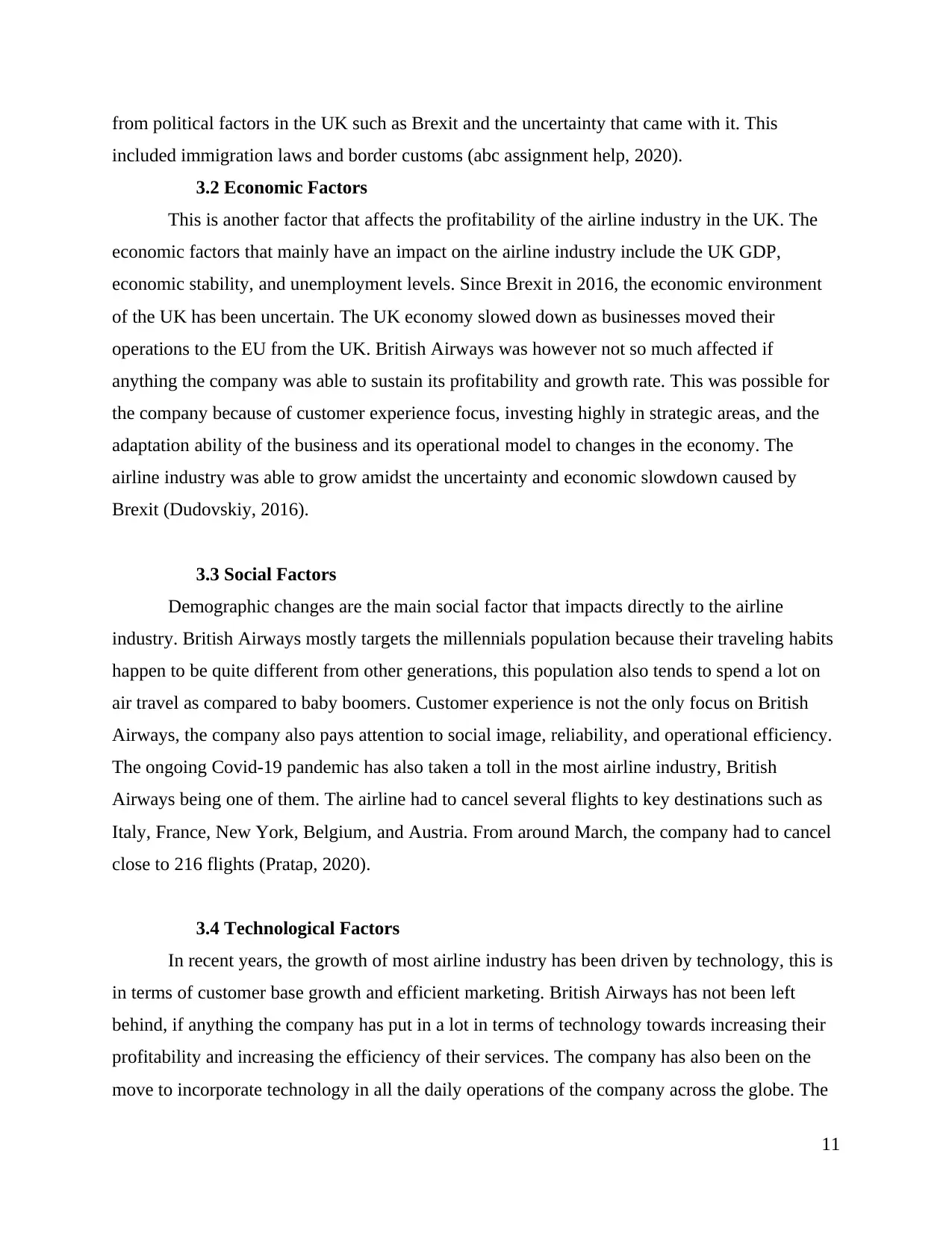
from political factors in the UK such as Brexit and the uncertainty that came with it. This
included immigration laws and border customs (abc assignment help, 2020).
3.2 Economic Factors
This is another factor that affects the profitability of the airline industry in the UK. The
economic factors that mainly have an impact on the airline industry include the UK GDP,
economic stability, and unemployment levels. Since Brexit in 2016, the economic environment
of the UK has been uncertain. The UK economy slowed down as businesses moved their
operations to the EU from the UK. British Airways was however not so much affected if
anything the company was able to sustain its profitability and growth rate. This was possible for
the company because of customer experience focus, investing highly in strategic areas, and the
adaptation ability of the business and its operational model to changes in the economy. The
airline industry was able to grow amidst the uncertainty and economic slowdown caused by
Brexit (Dudovskiy, 2016).
3.3 Social Factors
Demographic changes are the main social factor that impacts directly to the airline
industry. British Airways mostly targets the millennials population because their traveling habits
happen to be quite different from other generations, this population also tends to spend a lot on
air travel as compared to baby boomers. Customer experience is not the only focus on British
Airways, the company also pays attention to social image, reliability, and operational efficiency.
The ongoing Covid-19 pandemic has also taken a toll in the most airline industry, British
Airways being one of them. The airline had to cancel several flights to key destinations such as
Italy, France, New York, Belgium, and Austria. From around March, the company had to cancel
close to 216 flights (Pratap, 2020).
3.4 Technological Factors
In recent years, the growth of most airline industry has been driven by technology, this is
in terms of customer base growth and efficient marketing. British Airways has not been left
behind, if anything the company has put in a lot in terms of technology towards increasing their
profitability and increasing the efficiency of their services. The company has also been on the
move to incorporate technology in all the daily operations of the company across the globe. The
11
included immigration laws and border customs (abc assignment help, 2020).
3.2 Economic Factors
This is another factor that affects the profitability of the airline industry in the UK. The
economic factors that mainly have an impact on the airline industry include the UK GDP,
economic stability, and unemployment levels. Since Brexit in 2016, the economic environment
of the UK has been uncertain. The UK economy slowed down as businesses moved their
operations to the EU from the UK. British Airways was however not so much affected if
anything the company was able to sustain its profitability and growth rate. This was possible for
the company because of customer experience focus, investing highly in strategic areas, and the
adaptation ability of the business and its operational model to changes in the economy. The
airline industry was able to grow amidst the uncertainty and economic slowdown caused by
Brexit (Dudovskiy, 2016).
3.3 Social Factors
Demographic changes are the main social factor that impacts directly to the airline
industry. British Airways mostly targets the millennials population because their traveling habits
happen to be quite different from other generations, this population also tends to spend a lot on
air travel as compared to baby boomers. Customer experience is not the only focus on British
Airways, the company also pays attention to social image, reliability, and operational efficiency.
The ongoing Covid-19 pandemic has also taken a toll in the most airline industry, British
Airways being one of them. The airline had to cancel several flights to key destinations such as
Italy, France, New York, Belgium, and Austria. From around March, the company had to cancel
close to 216 flights (Pratap, 2020).
3.4 Technological Factors
In recent years, the growth of most airline industry has been driven by technology, this is
in terms of customer base growth and efficient marketing. British Airways has not been left
behind, if anything the company has put in a lot in terms of technology towards increasing their
profitability and increasing the efficiency of their services. The company has also been on the
move to incorporate technology in all the daily operations of the company across the globe. The
11
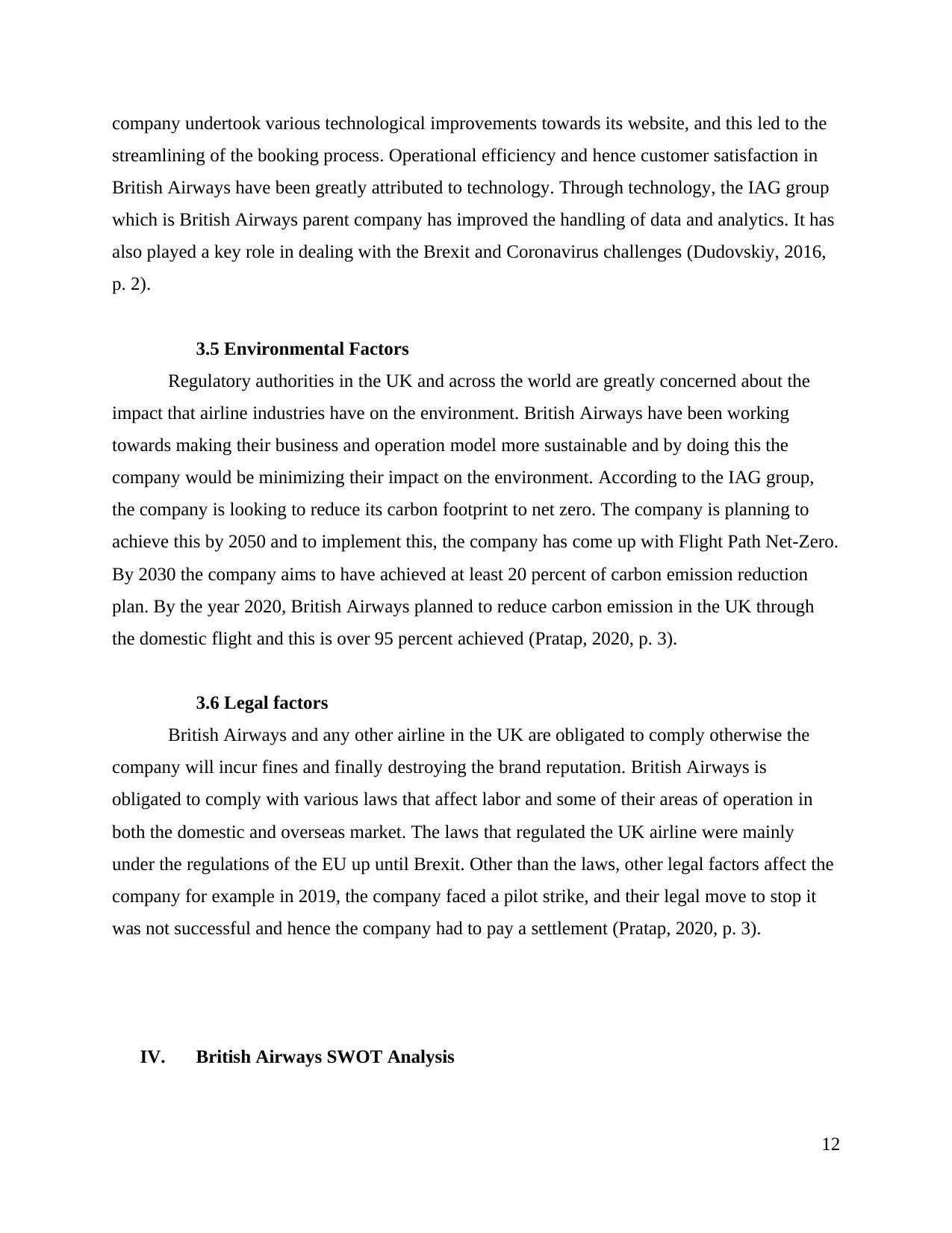
company undertook various technological improvements towards its website, and this led to the
streamlining of the booking process. Operational efficiency and hence customer satisfaction in
British Airways have been greatly attributed to technology. Through technology, the IAG group
which is British Airways parent company has improved the handling of data and analytics. It has
also played a key role in dealing with the Brexit and Coronavirus challenges (Dudovskiy, 2016,
p. 2).
3.5 Environmental Factors
Regulatory authorities in the UK and across the world are greatly concerned about the
impact that airline industries have on the environment. British Airways have been working
towards making their business and operation model more sustainable and by doing this the
company would be minimizing their impact on the environment. According to the IAG group,
the company is looking to reduce its carbon footprint to net zero. The company is planning to
achieve this by 2050 and to implement this, the company has come up with Flight Path Net-Zero.
By 2030 the company aims to have achieved at least 20 percent of carbon emission reduction
plan. By the year 2020, British Airways planned to reduce carbon emission in the UK through
the domestic flight and this is over 95 percent achieved (Pratap, 2020, p. 3).
3.6 Legal factors
British Airways and any other airline in the UK are obligated to comply otherwise the
company will incur fines and finally destroying the brand reputation. British Airways is
obligated to comply with various laws that affect labor and some of their areas of operation in
both the domestic and overseas market. The laws that regulated the UK airline were mainly
under the regulations of the EU up until Brexit. Other than the laws, other legal factors affect the
company for example in 2019, the company faced a pilot strike, and their legal move to stop it
was not successful and hence the company had to pay a settlement (Pratap, 2020, p. 3).
IV. British Airways SWOT Analysis
12
streamlining of the booking process. Operational efficiency and hence customer satisfaction in
British Airways have been greatly attributed to technology. Through technology, the IAG group
which is British Airways parent company has improved the handling of data and analytics. It has
also played a key role in dealing with the Brexit and Coronavirus challenges (Dudovskiy, 2016,
p. 2).
3.5 Environmental Factors
Regulatory authorities in the UK and across the world are greatly concerned about the
impact that airline industries have on the environment. British Airways have been working
towards making their business and operation model more sustainable and by doing this the
company would be minimizing their impact on the environment. According to the IAG group,
the company is looking to reduce its carbon footprint to net zero. The company is planning to
achieve this by 2050 and to implement this, the company has come up with Flight Path Net-Zero.
By 2030 the company aims to have achieved at least 20 percent of carbon emission reduction
plan. By the year 2020, British Airways planned to reduce carbon emission in the UK through
the domestic flight and this is over 95 percent achieved (Pratap, 2020, p. 3).
3.6 Legal factors
British Airways and any other airline in the UK are obligated to comply otherwise the
company will incur fines and finally destroying the brand reputation. British Airways is
obligated to comply with various laws that affect labor and some of their areas of operation in
both the domestic and overseas market. The laws that regulated the UK airline were mainly
under the regulations of the EU up until Brexit. Other than the laws, other legal factors affect the
company for example in 2019, the company faced a pilot strike, and their legal move to stop it
was not successful and hence the company had to pay a settlement (Pratap, 2020, p. 3).
IV. British Airways SWOT Analysis
12
⊘ This is a preview!⊘
Do you want full access?
Subscribe today to unlock all pages.

Trusted by 1+ million students worldwide
1 out of 17
Related Documents
Your All-in-One AI-Powered Toolkit for Academic Success.
+13062052269
info@desklib.com
Available 24*7 on WhatsApp / Email
![[object Object]](/_next/static/media/star-bottom.7253800d.svg)
Unlock your academic potential
Copyright © 2020–2025 A2Z Services. All Rights Reserved. Developed and managed by ZUCOL.




